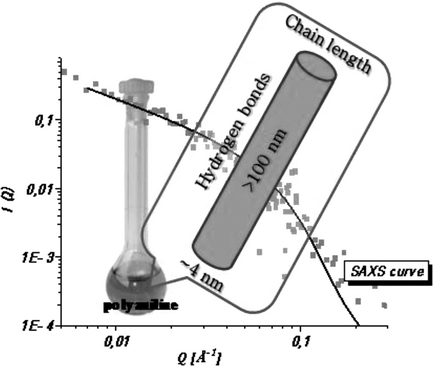J-Like Supramolecular Assemblies of Polyaniline in Water
Olga Omelchenko
Institute of Macromolecular Chemistry AS CR, Heyrovsky Sq. 2, 162 06 Prague 6, Czech Republic
A. N. Frumkin Institute of Physical Chemistry and Electrochemistry RAS, 31 Leninsky Prospect, 199071 Moscow, Russian Federation
Search for more papers by this authorElena Tomšík
Institute of Macromolecular Chemistry AS CR, Heyrovsky Sq. 2, 162 06 Prague 6, Czech Republic
Search for more papers by this authorAlexander Zhigunov
Institute of Macromolecular Chemistry AS CR, Heyrovsky Sq. 2, 162 06 Prague 6, Czech Republic
Search for more papers by this authorOlga Guskova
Leibniz Institute of Polymer Research, HoheStrasse 6, D-01069 Dresden, Germany
Search for more papers by this authorOxana Gribkova
A. N. Frumkin Institute of Physical Chemistry and Electrochemistry RAS, 31 Leninsky Prospect, 199071 Moscow, Russian Federation
Search for more papers by this authorCorresponding Author
Natalia Gospodinova
Institute of Macromolecular Chemistry AS CR, Heyrovsky Sq. 2, 162 06 Prague 6, Czech Republic
E-mail: [email protected]Search for more papers by this authorOlga Omelchenko
Institute of Macromolecular Chemistry AS CR, Heyrovsky Sq. 2, 162 06 Prague 6, Czech Republic
A. N. Frumkin Institute of Physical Chemistry and Electrochemistry RAS, 31 Leninsky Prospect, 199071 Moscow, Russian Federation
Search for more papers by this authorElena Tomšík
Institute of Macromolecular Chemistry AS CR, Heyrovsky Sq. 2, 162 06 Prague 6, Czech Republic
Search for more papers by this authorAlexander Zhigunov
Institute of Macromolecular Chemistry AS CR, Heyrovsky Sq. 2, 162 06 Prague 6, Czech Republic
Search for more papers by this authorOlga Guskova
Leibniz Institute of Polymer Research, HoheStrasse 6, D-01069 Dresden, Germany
Search for more papers by this authorOxana Gribkova
A. N. Frumkin Institute of Physical Chemistry and Electrochemistry RAS, 31 Leninsky Prospect, 199071 Moscow, Russian Federation
Search for more papers by this authorCorresponding Author
Natalia Gospodinova
Institute of Macromolecular Chemistry AS CR, Heyrovsky Sq. 2, 162 06 Prague 6, Czech Republic
E-mail: [email protected]Search for more papers by this authorAbstract
The consideration of polyaniline (PANI) as a supramolecular assembly similar to J-aggregates of dyes is proposed. Fibrils with a length of more than 100 nm and a diameter of about 4 nm are formed in water during aniline polymerization, as shown by small-angle X-ray scattering. Long-wavelength absorption of the fibrils, red-shifted with respect to highly crystalline PANI film supports the idea about the formation of J-aggregates. Their formation, similar to dyes, is promoted by the addition of a sulfonated polyelectrolyte and becomes more pronounced with an increase of the molar mass of the polyelectrolyte. Self-organization of aniline oligomers in a polar environment is confirmed by atomistic molecular dynamics simulations.
Supporting Information
As a service to our authors and readers, this journal provides supporting information supplied by the authors. Such materials are peer reviewed and may be re-organized for online delivery, but are not copy-edited or typeset. Technical support issues arising from supporting information (other than missing files) should be addressed to the authors.
| Filename | Description |
|---|---|
| macp201300429-sup-0001-S1.pdf1.9 MB | Supplementary |
Please note: The publisher is not responsible for the content or functionality of any supporting information supplied by the authors. Any queries (other than missing content) should be directed to the corresponding author for the article.
References
- 1J. Langer, Solid State Commun. 1978, 26, 839.
- 2E. M. Genies, A. Boyle, M. Lapkowsky, C. Tsintavis, Synth. Met. 1990, 36, 139.
- 3a) N. Gospodinova, D. A. Ivanov, D. V. Anokhin, I. Mihai, L. Vidal, S. Brun, J. Romanova, Al. Tadjer, Macromol. Rapid Commun. 2009, 30, 29; b) N. Gospodinova, V. Muşat, H. Kolev, J. Romanova, Synth. Met. 2011, 161, 2510; c) N. Gospodinova, E. Tomšík, J. Romanova, Chem. Pap. 2013, 67, 972.
- 4S. E. Sheppard, Rev. Mod. Phys. 1942, 14, 303 and references therein.
- 5H. von Berlepsch, C. Böttcher, S. Dähne, J. Phys. Chem. B 2000, 104, 8792.
- 6a) C. C. Rich, J. L. McHale, Phys. Chem. Chem. Phys. 2012, 14, 2362; b ) C. C. Rich, J. L. McHale, J. Phys. Chem. C. 2013, 117, 10856.
- 7V. Villari, P. Mineo, E. Scamporrino, N. Micalia, RSC Adv. 2012, 2, 12989.
- 8a) M. Liu, A. Kir, Thin Solid Films 2000, 359, 104; b) I. Moreno-Villoslada, J. P. Fuenzalida, G. Tripailaf, R. Araya-Hermosilla, G. del C. Pizarro, O. G. Marambio, H. Nishide, J. Phys. Chem. B 2010, 114, 11983 and references therein.
- 9Software Package SASfit for Fitting Small-Angle Scattering Curves, J. Kohlbrecher, Paul Scherrer Institute, Villigen, 2010, http://kur.web.psi.ch/sans1/SANSSoft/sasfit.html, accessed: August 2013.
- 10a) M. M. Ostwal, M. Sahimi, T. T. Tsotsis, Phys. Rev. E 2009, 79, 061801; b) M. M. Ostwal, T. T. Tsotsis, M. Sahimi, J. Chem. Phys. 2007, 126, 124903.
- 11S. Plimpton, J. Comput. Phys. 1995, 177, 1.
- 12J. Romanova, J. Petrova, A. Tadjer, N. Gospodinova, Synth. Met. 2010, 160, 1050.
- 13a) G.-L. Yuan, N. Kuramoto, Macromolecules 2002, 35, 9773; b) L. Li, L. Ferng, Y. Wei, C. Yang, H.-F. Ji, J. Colloid Interface Sci. 2012, 381, 11; c) N. Gospodinova, S. Dorey, A. Ivanova, H. Zhekova, A. Tadjer, Int. J. Polym. Anal. Char. 2007, 12, 251; d) O. L. Gribkova, A. A. Nekrasov, M. Trchova, V. F. Ivanov, V. I. Sazikov, A. B. Razova, V. A. Tverskoy, A. V. Vannikov, Polymer 2011, 52, 2474 and references therein.
- 14a) C. Wandrey, Phys. Chem. 1996, 100, 869; b) C. Wandrey, Langmuir 1999, 15, 4069; c)C. Wandrey, D. Hunkeler, U. Wendler, W. Jaeger, Macromolecules 2000, 33, 7136; d) U. Böhme, U. Scheler, Adv. Colloid Interface Sci. 2010, 158, 63; e) J. Tan, P. Marcus, J. Polym. Sci., Polym. Phys. 1976, 14, 239; f) R. A. Mock, C. A. Marshall, J. Polym. Sci. 1954, 13, 263; g) C. E. Harland, Ion Exchange: Theory and Practice, The Royal Society of Chemistry, Cambridge, UK 1994, p. 259.
- 15S. Dorey, C. Vasilev, L. Vidal, C. Labbe, N. Gospodinova, Polymer 2005, 46, 1309.





